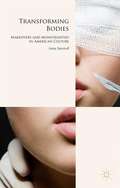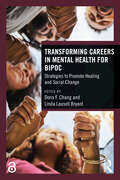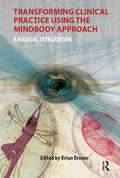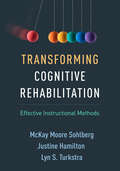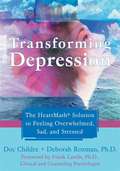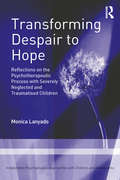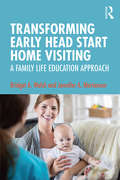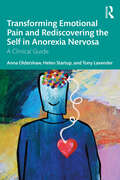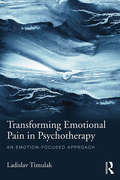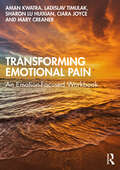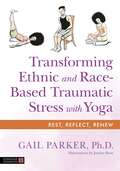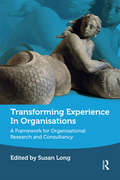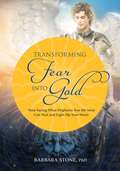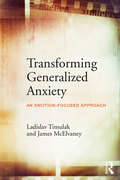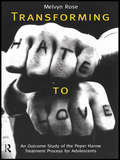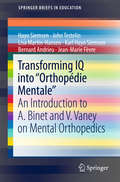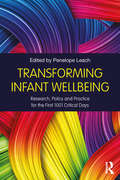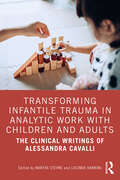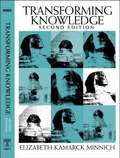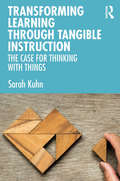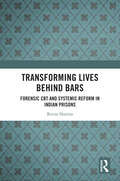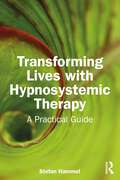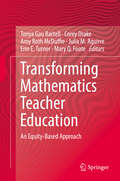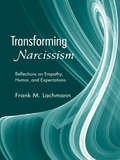- Table View
- List View
Transforming Bodies
by Heike SteinhoffAt the turn of the twenty-first century, American media abound with images and narratives of bodily transformations. Transforming Bodies investigates how these representations have become key sites for the negotiation of power. Focusing on the representations of 'extreme' forms of somatic transformations, particularly cosmetic surgery, this book examines iconic popular cultural texts from diverse media and genres. The reality TV show The Swan, the TV drama series Nip/Tuck, Chuck Palahniuk's(post-)postmodern novels Invisible Monsters and Invisible Monsters Remix, and Scott Westerfeld's young adult fiction series Uglies are read as expressions of the heterogeneous biopolitical discourses that are articulated in the American mediascape. In contemporary American culture, representations of body transformations are often part of a makeover paradigm that presents bodies as 'beautiful,' 'individual' and 'improved' if they adhere to normative constructions of gender, sexuality, class, race/ethnicity, and able-bodiedness. However, Transforming Bodies demonstrates that a number of popular cultural texts take up narrative structures, representational strategies and ideological underpinnings of makeover culture in order to re-write them. These texts link makeovers to images, practices, and narratives of monstrosity and thereby challenge cultural norms. At the crossroads of American, cultural, literary, media, gender, queer, disability and governmentality studies, the book presentsa timely intervention into critical debates on body transformations and contemporary makeover culture.
Transforming Careers in Mental Health for BIPOC: Strategies to Promote Healing and Social Change
by Doris F. Chang Linda Lausell BryantThis book provides targeted advice to Black, Indigenous, and People of Color (BIPOC) in the mental health professions on how to navigate, resist, and transform institutions and policies that were not designed for them.A diverse team of BIPOC leaders reveal their experiences of race-related stress and how they draw on cultural strengths and anti-oppressive frameworks to create more inclusive, equitable, and culturally affirming approaches to mental health training, research, and practice. This book illustrates how it is possible for BIPOC students and professionals to have a career that is more sustainable, allows authenticity to emerge, and sparks transformative change in clients, students, organizations, and society. It addresses the unique professional development needs of BIPOC individuals across different career stages and professional roles. Covering topics such as how to respond to microaggressions from patients, become a media contributor, or step into organizational leadership, each core chapter includes a discussion of the pertinent literature, culturally grounded theories, personal reflections, and actionable strategies for community healing and social change.This essential guide will inspire trainees, practitioners, educators, and administrators in the fields of social work, psychology, counseling, psychiatry, education, and public health, to envision a path toward a more culturally affirming and transformative career.The introduction, chapter 1, and chapter 25 of this book are freely available as downloadable Open Access PDF’s at http://www.taylorfrancis.com.
Transforming Clinical Practice Using the MindBody Approach: A Radical Integration
by Brian BroomThis book assumes that it is no longer tenable to work in healthcare without considering the person as a whole being constituted by a rich weaving of mind, body, culture, family, spirit and ecology. The MindBody approach embraces this 'whole.' But how does it transform clinical practice and training for the clinician and treatment for the patient/client? The book collects together the experiences from a diverse range of clinical practitioners (including psychotherapy, specialist medicine, general practice, physiotherapy, occupational therapy, dietetics, , nursing, and complementary and alternative medicine practitioners) who have deliberately chosen to integrate a MindBody philosophy and skill set in their clinical practices. All reflect deeply on their unique journeys in transforming their clinical encounters. Most have been trained in the dominant Western framework and have inherited the classical dualistic approach which typically keeps mind and body apart.
Transforming Cognitive Rehabilitation: Effective Instructional Methods
by McKay Moore Sohlberg Justine Hamilton Lyn S. TurkstraGrounded in cutting-edge knowledge about cognitive function and recovery from brain injury, this practical reference and text builds on the authors' influential earlier work, Optimizing Cognitive Rehabilitation. It incorporates major advances in the field to provide a new framework for assessing patients and developing individualized rehabilitation plans. The distinguished authors present principles and procedures for promoting engagement, teaching cognitive strategies and discrete facts and routines, introducing external cognitive aids, and supporting patients' social competence. Additional topics include considerations for using computer-based training, managing functional cognitive symptoms, and providing cognitive rehabilitation in the inpatient setting. The book features detailed case illustrations and filled-out examples of 19 reproducible planning and progress monitoring forms. Blank forms can be downloaded and printed in a convenient 8 1/2" x 11" size.
Transforming Depression: The Heartmath Solution To Feeling Overwhelmed, Sad, And Stressed
by Frank Lawlis Doc Childre Deborah RozmanThis latest offering from the Institute of HeartMath shows readers how to use the revolutionary HeartMath(r) tools like the Freeze-Framer(r) and the Heart Lock-In(r) to overcome feelings of sadness and depression associated with stress and the sense of being overwhelmed by the chaotic world in which we live.
Transforming Despair to Hope: Reflections on the Psychotherapeutic Process with Severely Neglected and Traumatised Children
by Monica LanyadoTransforming Despair to Hope: Reflections on the Psychotherapeutic Process with Severely Neglected and Traumatised Children offers a thorough overview of the problems and rewards of trying to help severely neglected and traumatised children. Drawing on over 40 cyears of clinical experience, Monica Lanyado provides a historical and social perspective on this challenging population, as well as helpful theoretical frameworks and thoughtful support for all professionals and clinicians working with these children. This book brings together selected past writings and new chapters from Lanyando. In it she describes the consequences of severe neglect and trauma on a child’s emotional development, and then goes on to examine what it is that brings about positive change. By using vivid clinical examples of therapeutic practice with these children, she elucidates the difficulties associated with this population, as well as for those who care for them in families and in residential settings. Transforming Despair to Hope is a valuable resource for child and adolescent mental health professionals and trainee clinicians, as well as those in related fields working with children in need.
Transforming Early Head Start Home Visiting: A Family Life Education Approach
by Bridget A. Walsh Jennifer A. MortensenResearch on home visiting shows that Early Head Start (EHS) home-based programs benefit from additional training and resources that streamline philosophy and content. In this essential guide, Walsh and Mortensen propose that alignment with Family Life Education’s (FLE) strengths-based methodology results in greater consistency through a model of prevention, education, and collaboration with families. This text is the first to outline linkages between FLE and EHS home visiting. It explores a qualitative study of FLE integrated in a current EHS home-based program and application of FLE methodology to home visiting topics. This approach will influence professional practice and provide a foundation for developing evidence-based home visiting practices. Online content accompanies the text, with videos demonstrating the FLE approach in action and discussion questions to encourage engagement with and understanding of the core material. Transforming Early Head Start Home Visiting: A Family Life Education Approach is essential reading for upper-level undergraduate and masters students in family studies and early childhood education, as well as practitioners working with children and families.
Transforming Education in Practice: In Search of a Community of Phronimos
by Wai-yan Ronald TangThis book inspires educational practitioners with special regard to the way how practice in the frontline service is able to inform leadership and policy decision. It empowers them to identify what features are counted as professional and how they could be turned into sources for developing wise judgment and eliciting creative acts in teaching, lesson planning and course design, collaboration, and knowledge excavation to shape policy decision and planning. In addition, for those who are used to conceive the world and their practice from a positivist tradition may find the insights of this book illuminating particularly when they are looking for a paradigm shift in understanding their practice. Last but not least, educators and teacher educators in particular will find the ideas in this book more promising in escalating the awareness of teachers of the next generation towards what is ‘good’ (phronesis) in terms of their professional attitude and actual performance (informed by both techne and episteme) in their relevant settings.
Transforming Emotional Pain and Rediscovering the Self in Anorexia Nervosa: A Clinical Guide
by Helen Startup Anna Oldershaw Tony LavenderThis book presents the SPEAKS approach, an innovative treatment model for anorexia nervosa that primarily combines aspects of Emotion Focused Therapy and Schema Therapy to target struggles with emotion expressed as a “Lost Emotional Self.”An important development for eating disorder treatment models over the last decade is the recognition of difficulties with emotions. This book offers a clear rationale for why emotion is critical in the understanding of anorexia, the blocks to emotional experiencing, as well as how this plays out in regard the development and experience of anorexia. Structured around five core phases, the treatment framework equips clinicians with practical tools and core therapy tasks designed to help clients reconnect with their emotions. By empowering individuals to articulate their emotional needs, this guide fosters healthier relationships with food and self, ultimately reducing reliance on maladaptive behaviours associated with anorexia.Transforming Emotional Pain and Rediscovering the Self in Anorexia Nervosa is an essential resource for helping any clinician working in the eating disorder field guide their clients toward emotional healing and self-acceptance.
Transforming Emotional Pain in Psychotherapy: An emotion-focused approach
by Ladislav TimulakEmotion-focused therapy is a research-informed psychological therapy that to date has mainly been studied in the context of depression, trauma and couple distress. The evidence suggests that this therapy has a lasting and transformative effect. Ladislav Timulak presents EFT as a particular therapeutic approach that addresses psychological human suffering, offering a view that puts more emphasis on attending to the distress, rather than avoiding or suppressing it. Focusing on the latest developments in EFT, Transforming Emotional Pain in Psychotherapy presents a theory of human suffering and a model of therapy that addresses that suffering. The model of suffering assumes that the experienced emotional pain is a response to an injury that prevents or violates the fulfilment of the basic human needs of being loved, safe, and acknowledged. This book focuses on a particular way of transforming emotional pain in psychotherapy through: helping the client to tolerate the pain; assisting the client to identify the core of the difficult emotional experiences; identifying the needs connected to the core pain which are unmet or being violated, and responding (with compassion and protective anger) to the underlying needs of the client that transforms the original pain. Transforming Emotional Pain in Psychotherapy provides an account of how emotional pain can be conceptualised and how it can be addressed in therapy. It provides practical tips for therapists working with emotional pain and shows how it can then be made more bearable and transformed allowing the client to be more sensitive to the pain of others, and to seek support when needed. This book will be essential reading for clinical and counselling psychologists, psychotherapists and counsellors in practice and training, as well as for fully qualified professionals undergoing further training in EFT.
Transforming Emotional Pain: An Emotion-Focused Workbook
by Ladislav Timulak Mary Creaner Ciara Joyce Aman Kwatra Sharon Lu HuixianTransforming Emotional Pain presents an accessible self-help approach to mental health based on Emotion-Focused Therapy (EFT). Based on the principles of EFT, and developed by clinicians and researchers, this client-focused workbook is designed to supplement psychotherapy and can also serve as a self-help book. It will help readers learn how to regulate feelings that are unpleasant and transform painful feelings, so that they can fulfil their needs and feel more connected and empowered in their lives. Providing a step-by-step sequential guide to exploring, embracing, and transforming emotions, the various chapters guide the reader to help overcome emotional avoidance, with sections on: transforming the emotional self-interrupter; transforming the inner self-worrier; transforming the self-critic; and healing from emotional injury. This workbook can be used by trained therapists, mental health professionals, psychology professionals, and trainees as supplementary to their therapeutic interventions with clients. It can also be used by general readers with an interest in self-help literature and resources or anyone wanting to explore, embrace, and transform their emotions.
Transforming Ethnic and Race-Based Traumatic Stress with Yoga
by Gail ParkerBuilding on the foundations of Restorative Yoga for Ethnic and Race-Based Stress and Trauma by Gail Parker, this workbook offers a range of self-care practices that strengthen the psychological immune system, increase resilience, and support post-traumatic growth.Ethnic and race-based traumatic stress is a worldwide phenomenon. Regardless of race and ethnicity we are all impacted by its damaging effects, from those who are wounded to those who do the wounding. We are witnessing health care disparities based on race and ethnicity that are causing great suffering, and also witnessing a global awakening to the pandemic of racial violence and its pernicious effects on all of us.Transforming Ethnic and Race-Based Traumatic Stress with Yoga is a self-care study guide where each chapter includes a reading for contemplation on an area of ethnic and/or race related traumatic stress, an illustration of a Restorative Yoga pose with instructions on how to get into it and accompanied by positive affirmations to repeat while in the pose. This is followed by a therapeutic journal writing instruction with blank pages for journal entries to reinforce the affirmations and to identify the psychological, mental, emotional, and spiritual benefits of the posture presented.
Transforming Experience in Organisations: A Framework for Organisational Research and Consultancy
by Susan LongThis book demonstrates how the transforming experience framework (TEF) model can be used in organisational analysis, research, and consulting. It analyses the use of the TEF for examining both theoretical and practical issues in the field of socioanalysis and systems psychodynamics.
Transforming Fear Into Gold: How Facing What Frightens You Most Can Heal and Light Up Your Life
by Barbara Stone Janet Nester Karen Kane Stephanie Marohn"Transforming Fear into Gold" is a guide to converting your greatest fears--fear of dying, fear of poverty, fear of annihilation, fear of the unknown--into energy you can use to burst the limitations that bind you and expand into your full human potential. Dr. Stone demonstrates this metamorphosis with a variety of inspiring case histories from her psychotherapy practice using her step-by-step Soul Detective Detrimental Energy Protocol. The protocol calls in angelic protection, identifies harmful influences, finds the cognitive distortions running the fears, and shines the golden light of consciousness into the dark places to heal the heart and restore the soul. She gives detailed and graphic accounts of how to reach people stuck in dark places and bring them into the light.
Transforming Generalized Anxiety: An emotion-focused approach
by Ladislav Timulak James McElvaneyTransforming Generalized Anxiety: An Emotion Focused Approach examines an approach to treating generalized anxiety disorder (GAD) which attempts to uncover the deeper, underlying emotional experiences that clients are afraid of. It also demonstrates how these painful experiences can be transformed in therapy into a form of emotional resilience by generating experiences of self-compassion and healthy, boundary setting, protective anger. Though most of the literature on treating GAD is dominated by Cognitive Behavior Therapy, this book presents emotion-focused therapy as an alternative treatment of this condition. The emotional resilience this particular approach instils serves as a resource when encountering triggers of emotional vulnerability, but also decreases the client’s need to avoid hitherto feared triggers and the emotional experiences they bring. Developed in a series of research studies, and illustrated with reference to case examples, this book offers a practical, theoretically informed, evidence based guide, to conducting therapy with clients. Using clinical material, and applying the outcome of a series of research studies, Transforming Generalized Anxiety will equip psychotherapists and counsellors with the means to help GAD clients transform core painful experiences into a sense of empowerment and inner confidence.
Transforming Hate to Love: An Outcome Study of the Peper Harow Treatment Process for Adolescents
by Melvyn RoseThe Peper Harow residential community was founded in 1970 and gained international repute for its pioneering work with disturbed adolescents. For over 20 years, this remarkable establishment provided a therapeutic environment for teenagers who had often suffered appalling abuse, and yet for whom the state's only remedial provision until then had been in the punitive form of the approved schools. In Transforming Hate to Love Melvyn Rose, the community's founder, assesses Peper Harow's success in managing disturbed behaviour, and offers views on areas where the establishment could have responded more effectively to the needs of its residents. His study is complemented by the testimony of ex-residents helped by Peper Harow to overcome their fears and abandon their disruptive behaviour. The overwhelmingly positive outcome indicates the need for a review of current social policy towards deviant youth and shows how society as a whole would benefit from a psychodynamic view of the causes of criminality and mental ill-health among the young.
Transforming IQ into “Orthopédie Mentale“: An Introduction to A. Binet and V. Vaney on Mental Orthopedics (SpringerBriefs in Education)
by Hayo Siemsen John Testelin Lisa Martin-Hansen Karl Hayo Siemsen Bernard Andrieu Jean-Marie FèvreThis volume discusses Alfred Binet’s works on pedagogy based on his “Orthopédie Mentale”. Binet had empirically found that his idea of a test of general intelligence could be replaced by a test on “problem areas”. These problem areas were then to be specifically addressed and improved within a relatively short time. As a result, students dramatically improved in their IQ test results. Binet died before he could publish the results. Fortunately, the rector of the school, Victor Vaney, published the results of Binet’s experiments in his school. This volume provides the first English translation of Vaney's publication as well as an introduction to Binet's mostly forgotten late work.
Transforming Infant Wellbeing: Research, Policy and Practice for the First 1001 Critical Days
by Penelope LeachTransforming Infant Wellbeing brings together science and policy to highlight the critical importance of the first 1001 days of infancy: the period from conception to the second birthday. Introduced and edited by Penelope Leach, who uniquely combines academic knowledge of infant development with the ability to write about it for wide audiences, the book has at its heart 25 original articles by acknowledged experts in different aspects of infant health and development. Brought together, they showcase innovative science and best practices to a wide range of readers: to scientific colleagues in different disciplines; to politicians and policy makers; to local authority commissioners and specialist advisors, statutory and voluntary organisations and parents. This book has a two-fold purpose in science and in social policy. First, to collect new papers by leading scientists in a single volume, which ensures they reach a broad audience. Second, by introducing and commenting on the significance of these new findings, the book highlights both the benefits that accrue to society when it acts accordingly, and the costs, financial and social, of our failure to do so. In the last 50 years, interest in infant development and especially maternal and infant mental health has burgeoned. A large number of issues at the forefront of child development research mirror those of yesterday, but the research brought to bear upon them has transformed. Thanks largely to technological and statistical advances, we now know a great deal that researchers of earlier generations could only surmise. However, increasing knowledge of infancy has not been matched by an increasing impact on parents and professionals, politicians and policy makers. Bringing contemporary studies involving pregnancy, birth, infancy and toddlerhood together, along with the undisputed evidential findings that flow from them, large gaps between what is known and what is done become apparent. By focusing on what can be done to fill those gaps, Transforming Infant Wellbeing renders inescapable the need to rethink current priorities. It represents essential reading for researchers, parents and policy makers of infancy.
Transforming Infantile Trauma in Analytic Work with Children and Adults: The Clinical Writings of Alessandra Cavalli
by Lucinda Hawkins Martha StevnsThis vivid and moving volume presents the clinical work and writings of Alessandra Cavalli, an internationally known child and adult psychoanalyst who taught and supervised widely, ran infant observation seminars in the UK and Europe and was closely involved in the development of child analysis training in Russia. Informed by a deep knowledge of theory, each chapter draws on many strands of both psychoanalytic and Jungian thought, integrating multiple analytic languages into a coherent clinical language specific to Cavalli. The book includes 11 of her most important papers about work with children and adults, with an introduction by the distinguished Jungian psychoanalyst Warren Colman. Her work was primarily concerned with the impact of trauma on the developing self and the importance of weathering emotional storms in search of meaning, and the book will be fascinating reading for clinicians of different psychoanalytic approaches working with adults and children as well as students of psychotherapy and counselling.
Transforming Knowledge, Second Edition
by Minnich Elizabeth KamarckThis is a book about how we define knowledge and how we think about moral and political questions. It argues that the prevailing systems of knowledge, morality, and politics are rooted in views that are exclusionary and therefore legitimate injustice, patriarchy, and violence. That is, these views divide humans into different kinds along a hierarchy whose elite still defines the systems that shape our lives and misshape our thinking. Like the first edition of Transforming Knowledge, this substantially revised edition calls upon us to continue to liberate our minds and the systems we live within from concepts that rationalize inequality. It engages with the past fifteen years of feminist scholarship and developments in its allied fields (such as Cultural Studies, African American Studies, Queer Studies, and Disability Studies) to critique the deepest and most vicious of old prejudices. This new edition extends Minnich's arguments and connects them with the contemporary academy as well as recent instances of domination, genocide, and sexualized violence. * Updated to consider recent scholarship in Gender, Multicultural, Postcolonial, Disability, Native American, and Queer Studies, among other fields of study * Revised to include an extended analysis of the conceptual errors that legitimate domination, including the construction of kinds ("genders") of human beings * Revised to include new materials from a variety of cultures and times, and engages with today's contemporary debates about affirmative action, postmodernism, and religion
Transforming Learning Through Tangible Instruction: The Case for Thinking With Things
by Sarah KuhnTransforming Learning Through Tangible Instruction offers a transformative, student-centered approach to higher education pedagogy that integrates embodied cognition into classroom practice. Evidence across disciplines makes clear that people learn with their bodies as well as their brains, but no previous book has provided evidence-based guidance for adopting and refining its practice in colleges and universities. Collecting findings from cognitive science, educational neuroscience, learning theories, and beyond, this volume’s unique approach—radical yet practical, effective yet low-cost—will have profound implications for higher education faculty and administrators engaged in teaching and learning. Seven concise chapters explore how physical objects, hands-on making, active construction, and other elements of body and environment can enhance comprehension, memory, and individual and collaborative learning.
Transforming Lives Behind Bars: Forensic CBT and Systemic Reform in Indian Prisons
by Reena SharmaThis volume emerges from the author’s extensive professional journey spanning over two decades, drawing from her work in behavioural sciences, training, and applied psychology. Rooted in research and fieldwork within Indian correctional institutions, it brings together internationally validated psychological assessments adapted for forensic populations, biopsychosocial evaluations, and qualitative and quantitative methodologies. It offers a compelling fusion of narrative case studies and evidence-based forensic psychology, bridging scientific inquiry with real-world complexity, moving beyond traditional academic boundaries. Drawing on global frameworks such as Forensic Cognitive Behavioural Therapy (CBT) and therapeutic jurisprudence, the book highlights the Samarth: Breaking Barriers initiative launched at Ahmedabad Central Jail and then extended in other central prisons of Gujarat, as an applied model tailored to the Indian correctional context. The initiative ethically adapts international best practices to align with institutional realities and cultural dynamics, making it a potential reference point for similarly under-resourced or high-need environments.Aimed at policymakers, forensic psychologists, criminologists, penologists, mental health professionals, and those working in correctional administration and criminal justice reform, the volume illustrates the potential of structured, ethical, and culturally responsive rehabilitation. It will also be a valuable resource for students, researchers, and practitioners across psychology, psychiatry, penology, correctional administration, social welfare, and correctional mental health.
Transforming Lives with Hypnosystemic Therapy: A Practical Guide
by Stefan HammelThis book provides a practise-based introductory guide for practitioners wishing to integrate hypnosystemic therapy into their services, examining its roots, principles, and methods.Hypnosystemic therapy combines aspects of Ericksonian hypnosis, Systemic Therapy, and parts/constellation therapy into a creative awake hypnotherapy approach. This is then further consolidated in therapy or counselling. It is applied for overcoming psychological, medical, and social problems by use of conversational hypnosis mostly without trance induction. This text discusses how the intervention can be used in a variety of group and individual settings, in the treatment of diagnoses such as ADD/ADHD, allergies, hypertension, anxiety, phobias, sleeping disorders, addiction and eating disorders, and autism spectrum disorders. Chapters provide therapeutic tools in a straightforward, practical manner with examples.Presenting therapeutic interventions in such a clear way that they can be integrated instantly into the therapeutic work of any school, this book is of particular interest to systemic therapists, behavioral therapists, and others who wish to integrate hypnotherapy knowledge into their work, but remains relevant to any mental health or allied professional.
Transforming Mathematics Teacher Education: An Equity-Based Approach
by Erin E. Turner Tonya Gau Bartell Corey Drake Amy Roth McDuffie Julia M. Aguirre Mary Q. FooteThis book builds on the Teachers Empowered to Advance Change in Mathematics (TEACH Math) project, which was an initiative that sought to develop a new generation of preK-8 mathematics teachers to connect mathematics, children’s mathematical thinking, and community and family knowledge in mathematics instruction – or what we have come to call children’s multiple mathematical knowledge bases in mathematics instruction, with an explicit focus on equity. Much of the work involved in the TEACH Math project included the development of three instructional modules for preK-8 mathematics methods courses to support the project’s goals. These activities were used and refined over eight semesters, and in Fall 2014 shared at a dissemination conference with other mathematics teacher educators from a variety of universities across the United States. Chapter contributions represent diverse program and geographical contexts and teach prospective and practicing teachers from a variety of socioeconomic and ethnic backgrounds, in particular providing accounts of supports, challenges, and tensions in implementing equity-based mathematics teacher education. The chapters supply rich evidence and illustrative examples of how other mathematics teacher educators and professional developers might make the modules work for their unique practices, courses, workshops, and prospective teachers/teachers. It promises to be an important resource for offering guidance and examples to those working with prospective teachers of mathematics who want to create positive, culturally responsive, and equity-based mathematics experiences for our nation’s youth.
Transforming Narcissism: Reflections on Empathy, Humor, and Expectations (Psychoanalytic Inquiry Book Series #Vol. 28)
by Frank LachmannUsing Kohut's seminal paper "Forms and Transformations of Narcissism" as a springboard, Frank Lachmann updates Kohut's proposals for contemporary clinicians. Transforming Narcissism: Reflections on Empathy, Humor, and Expectations draws on a wide range of contributions from empirical infant research, psychoanalytic and psychotherapeutic practice, social psychology, and autobiographies of creative artists to expand and modify Kohut's proposition that archaic narcissism is transformed in the course of development or through treatment into empathy, humor, creativity, an acceptance of transience and wisdom. He asserts that empathy, humor, and creativity are not the goals or end products of transformations, but are an intrinsic part of the ongoing therapist-patient dialogue throughout treatment. The transformative process is bidirectional, impacting both patient and therapist, and their affect undergoes transformation - for example from detached to intimate - and narcissism or self-states are transformed secondarily as a consequence of the affective interactions. Meeting or violating expectations of emotional responsivity provides a major pathway for transformation of affect. For beginning therapists, Transforming Narcissism presents an engaging approach to treatment that incorporates the therapeutic action of these transformations, but also leaves room for therapists to develop styles of their own. For more experienced therapists, it fills a conceptual and clinical gap, provides a scaffold for crucial aspects of treatment that are often unacknowledged (because they are not "analytic"), or are dismissed and pejoratively labeled "countertransference." Most importantly, Lachmann offers a balance between therapeutic spontaneity and professional constraint. Focused and engaging, Transforming Narcissism provides a bridge from self psychology to a rainbow of relational approaches that beginning and seasoned therapists can profitably traverse in either direction. Dr. Lachmann contributed to an article on empathy in the April, 2008 issue of O magazine, pp. 230.
